You’ve probably heard or read this somewhere: “Neon Genesis Evangelion is a deconstruction of the mecha genre” – or of SF, or even of shounen as a whole, if the person writing this is ambitious. This interpretation of one of the most famous mecha series ever is almost universal in the non-Japanese fandom, and you very probably shared it at some point. But the thing is, it’s wrong. Very wrong, even. I’d go so far as to say it’s a total misunderstanding, which leads you to miss a lot of what Evangelion’s going for.
It would be easy to directly refute this kind of interpretation by just taking a random Evangelion analysis and breaking it down. I won’t do that and stay at a more general level – I’m interested in the show, not the discourse around it. Though I’ll generally caution you against throwing the word “deconstruction” all around…
The other thing I won’t be doing will be a list of references. Indeed, if I wanted to show that Evangelion is the most otaku anime you’ve ever seen and that Hideaki Anno is a big nerd, I’d just need to do that. It would certainly be a lot of fun, but this isn’t my objective either. The first reason is because, if I wanted to do it like that, you’d have to wait a few years for me to hunt down the impressive lineup of citations the show makes. The other is that, as much as I appreciate and admire the efforts of people doing this kind of research, I don’t think it’s the most interesting. It tells us what are the references, but not what the show does with them.
Finally, something I’d like to avoid would be taking Anno’s (or any of the staff’s) word too literally. If possible, I’d even like to make this analysis without mentioning them at all. It’s not that I think that they don’t have anything relevant to say, on the contrary. But on the other hand, taking their word as the sole reference can be misleading. On the side of the “Evangelion as deconstruction” interpretation, people will put all the blame on Anno’s depression and his supposed disillusion with the otaku fandom. But on the other side, in otaku circles, fans might end up just listing all the references Anno as an individual made, and how much of an otaku he actually is, something I just said I wouldn’t do. Both those interpretative options tell us a lot about Anno (or do they really ?) but they don’t tell us much about Evangelion.
Like our content? Feel free to support us on Ko-Fi!
A bit of context
First, let’s start by replacing Evangelion in its historical and generic context. Doing so will help us understand better from what perspective the show is addressing its initial audience. This is even more relevant considering the fact that Hideaki Anno’s works often put a lot of importance on their historical context: in the beginning of the episodes of Kare Kano, the narrator starts by introducing us to the “lost decade” of 90’s Japan and economical depression. Similarly, Gunbuster’s triumphant and over the top tone can be better understood from the perspective of bubble-era Japan, one of the richest and most prosperous countries in the world back then.
Evangelion came out in 1995, a much darker time than the late 80’s. In 1991, the economic bubble that had enabled the country to get so rich burst, initiating a long period of economic recession – the one Kare Kano’s narrator constantly reminds us of. 1995 specifically was not a particularly happy year either. In February, a strong earthquake hit the city of Kobe, killing more than 6,000 people and offering a taste of what a ruined, apocalyptic city could be like. The same year, the 20th of March, religious sect Aum Shinrikyo launched a terrorist attack in Tokyo’s subway, killing 13 and injuring more than 6,000. Both events were traumatic for Japan as a nation, and Evangelion’s dark thematics and setting are often understood as a reaction to them.
This is probably partly true, but it’s necessary to go a little further. The first key event to understand Evangelion’s relationship with otaku (as people and as culture) was the Tsutomu Miyazaki affair. Between 1988 and 1989, Miyazaki abducted and murdered four young girls, aged from 4 to 7. He was arrested on July 23, 1989, and this caused a nation-wide moral panic when the police found a large collection of anime videotapes in his apartment. He was subsequently referred to as “the otaku murderer”, which propagated the image of otaku as dangerous, psychotic and antisocial individuals.
- Of course, the otaku themselves tried to set up a defense. The most important figure in this was Toshio Okada, one of the founding members of studio Gainax and its president until 1992. The self-proclaimed “Otaking” first directed an OVA retelling the history of Gainax, Otaku no Video, in 1991. Rather than presenting the otaku as dangerous and perverse beings, he showed them in a more positive light: dorks, but passionate and playful ones. In its fake interview segments, the OVA also directly parodied the mediatic construction of otaku as dangerous and socially/intellectually handiccaped. Then, in 1992, Okada published his first book, Introduction to Otakuology, in which he tried to demonstrate that otakus were “the true heirs of Japanese culture” and had to be reevaluated.
Evangelion is generally understood as a negative reaction to the Miyazaki affair: it demonstrated otaku were dangerous for society, and decided to attack the otaku on their own ground, that is mecha anime. But this is completely misled, and the team behind Evangelion probably shared Okada’s agenda: defend and revitalize otaku culture rather than try to destroy it. And it is what happened: if the Miyazaki incident put a brutal end to the “lolicon boom” of the 80’s, Evangelion and its influence played a large part in the “moe boom” that would take over anime in the 2000’s.
This can also be understood by taking a short look at TV anime productions before Evangelion, especially in SF, the genre it is supposed to have deconstructed. The mecha genre in particular was going through some evolution. With some exceptions (most notably Victory Gundam), the genre of real robot and its dramatic, dark storylines, was in relative decline. On the other hand, super robot and mecha aimed at kids were going through a major revival, as indicated by the success of the Brave series. Even the Gundam franchise went in this more light-hearted direction with Mobile Fighter G in 1994.
As for shows aimed more specifically at otaku, deconstruction was getting trendy. Or, rather than deconstruction, parodies. The most notable one before Evangelion was Irresponsible Captain Tylor in 1993, with its gentle jabs at the space opera genre. And, just after Evangelion, there was Martian Successor Nadesico in 1996. Both shows directly addressed (much more directly than Evangelion) the collusions between nationalism/militarism and Japanese science fiction, especially in an otaku context. Although Evangelion did it with a much darker tone, a parallel with Nadesico is quite instructive. Evangelion shows brutality, violence and abuse, but never explicitly criticizes them as a part of its generic codes. These are features of the world, and even if this wasn’t a mecha show, these things would still exist: the show’s abundant use of psychoanalysis makes clear these are universal issues. On the other hand, Nadesico clearly diagnoses violence and militarism as features of its own genre and tries to offer a way out from those trappings. But even then, Nadesico is a quintessentially otaku work, with its harem, Getter Robo references and cool robots.
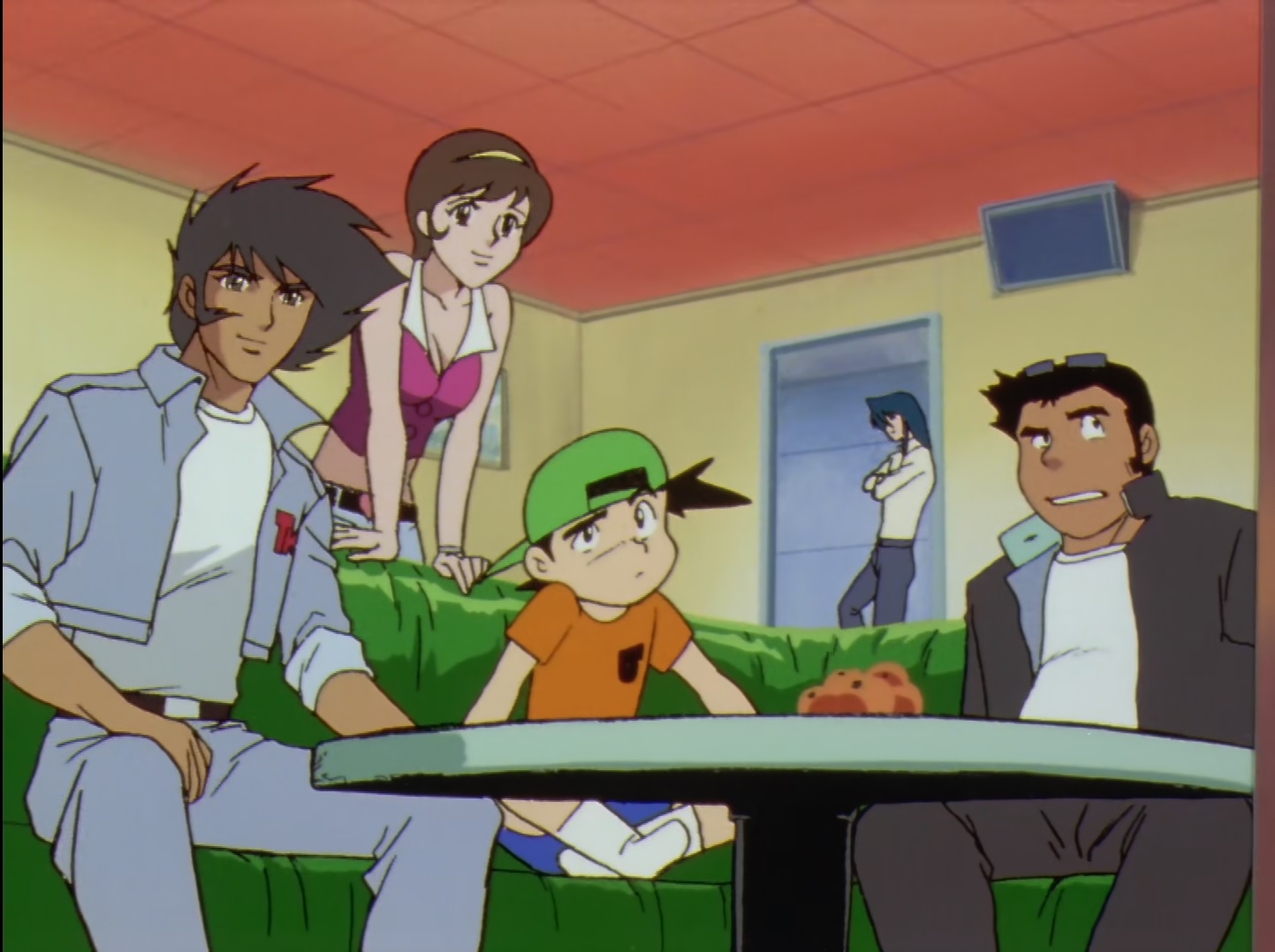
An example of Nadesico‘s meta construction : the characters from the in-show super robot, Gekiganger 3, are watching the recap episode of Nadesico
The last element of context is proper to the history of Gainax itself. The studio had always had management issues, but in the 90’s, it was on the constant brink of collapse. As early as 1992, the staff was trying to find ways of producing a successful work that could bring the money in. Their project back then was to make a sequel to their first movie, Royal Space Force: The Wings of Honneamise. This cursed project, Uru In Blue, never saw the light of day, but what’s interesting here is that the studio’s first idea was to go back over their previous work, and not create something completely original. Although no one could have predicted Evangelion’s success, it was already hoped to be the project that could save Gainax from its financial problem. And, just like Uru In Blue, it could only achieve that by looking back and paying homage to Gainax and, more generally, otaku culture as a whole.
Fanservice, and Evangelion’s structure
With all this being said, it’s time to take a look at Evangelion itself. All the contextual elements I mentioned could be, after all, purely coincidental, and I might be wrong. Looking at the actual show is therefore necessary. Generally, people insist on Evangelion’s dark aspects, its focus on psychology and violence. I will demonstrate that such elements are not exceptional in a mecha show in the next section, but for now, I just want to remind that this is not what the series is all about. On the contrary, analyzing it without mentioning all the “non-dark” moments is missing a lot about Evangelion.
To understand this, it might be necessary to take a look at Hideaki Anno’s other works. Just a cursory glance will show you that tone shifts are one of the most prevalent features of his style. But you’ll also quickly see that these shifts are often misunderstood, if not hated, by the audience. Think of Nadia’s infamous “desert island” arc (although this one has other problems and Anno’s responsibility on it is debated at best) and Kare Kano’s more comedic episodes. This is the same for Evangelion: the lighter episodes of the show are generally considered as the least interesting, the moment when the show stumbles, simply because they don’t fit the image of the show.
Evangelion’s tonal shift is heavily linked to one character: Asuka. Who is, unsurprisingly, one of the most debated characters of the franchise, many fans finding her annoying. I’m not going to argue over that, but the fact is that it’s mostly around Asuka that the show’s tones change. Although the shift was already palpable in episode 7, it’s in episode 8, Asuka’s arrival, that the show suddenly integrates much more comedic moments and that the over the top aspect of the scenarios becomes completely apparent. But even then, it’s nothing completely new: in case you had forgotten, episode 6 is about redirecting the entirety of Japan’s energy into a single rifle. This is the kind of completely crazy strategy that you’d only find in kaiju movies or mecha anime.
Then, until episodes 15-16, the show adopts a classical monster of the week format, directly taken from tokusatsu series and mecha anime. It contains some of the most improbable scenarios (such as the combined attack of Units 1 and 2 in episode 9) as well as some of the most fun and/or annoying interactions between the members of the cast (episodes 10-11). This middle part of the show maintains the mysterious, sometimes dark atmosphere of the rest, but its focus is different. It is mostly about the main trio of pilots and their interactions. It is also there that the show goes the furthest in the romance department, with the pathetic but most of all comedic kissing scene from episode 15. In retrospect, once you’re done or have reflected on the show, this scene will appear as a sad moment, yet another failure in the communication between the characters. This is true, but let’s not forget that this moment is also meant to be fun: we’re meant to laugh at Shinji’s awkwardness as he holds his breath and can’t kiss Asuka properly.
It’s also in this middle part of the show, and still around Asuka, that fanservice really starts appearing. When discussing Evangelion and fanservice, it’s customary to evoke episode 5, when Shinji stumbles upon a naked Rei. This scene is indeed disturbing, as the comical/sexy moment we’re expecting is replaced by something incredibly awkward. But that’s not all of what the series has to offer in terms of fanservice: just after this unexpected play with the rules, Evangelion plays it perfectly by the book in episode 8. Or rather, it goes even further: after a completely gratuitous shot of Asuka’s panties, the show decides to push it up to eleven as Toji takes off his own pants. The obligatory slaps follow.
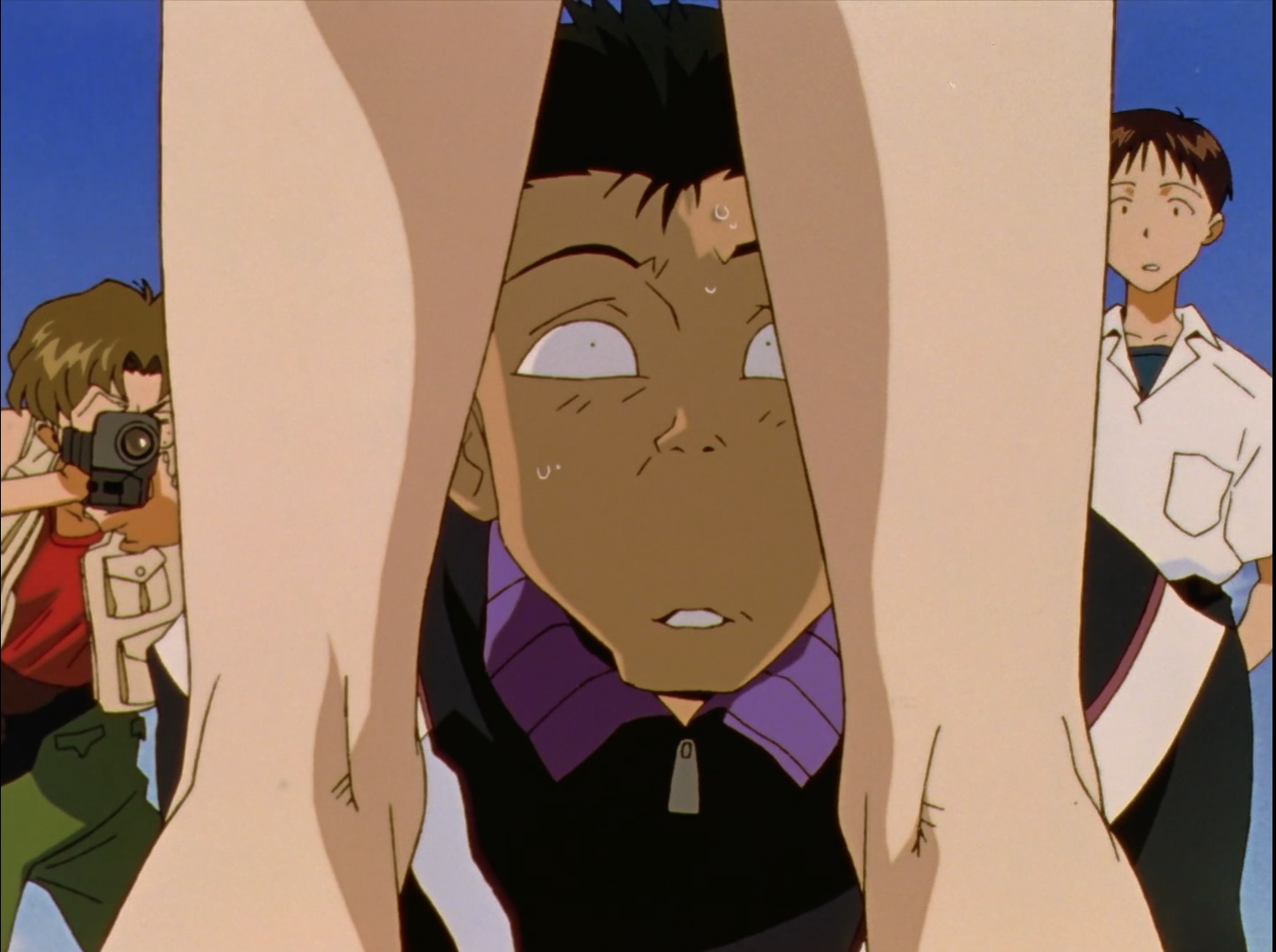
And this isn’t the only instance: two episodes after that, Asuka very obviously shoves her breasts in Shinji’s face, and said Shinji stares down Asuka’s cleavage in at least one occasion. The show clearly knows what it’s doing: every time, there’s just enough room for the viewer to distance themselves from the fanservice. But it is doing it, and Asuka as a character is clearly inviting at least Shinji (and Kaji, or at least she wishes that were the case) to look at her in a sexual fashion. This is both tragic and comical: as in episode 8’s panty shot, the fanservice is more meant to be funny than really sexually titillating.
Someone with better knowledge than me could probably discuss in greater depth many other storytelling elements, such as the giant conspiracy webs, or the many monster-of-the-week scenarios and/or Angel designs taken directly from tokusatsu or super sentai series. But the one thing to remember is that in all those aspects, Evangelion doesn’t always take itself that seriously.
From Ide to Eva
But the fact that it contains some funny moments isn’t enough to make Evangelion look just like any mecha. It’s still possible to dismiss this (“they had to please the fans”, or “the producers asked for it”) and argue that, in the other aspects, the show is original and groundbreaking. After all, once you’ve seen it all, it’s very possible to come back on those moments of fanservice and see they’re mostly used for character development. The psychology of the characters is so well handled, and that has to be original.
Well, not really. Once again, I’m not going to make a list of references and cameos, but there’s at least one I have to make: the influence of Yoshiyuki Tomino’s work. Tomino can arguably be called one of the greatest masters of mecha anime and the creator of real robot – that is, mecha series that focus on worldbuilding and character psychology. Starting with 1977’s Zambot 3, he really revolutionized the genre in 1979 in Mobile Suit Gundam. There would be much to say on the similarities between Shinji and Amuro, Gundam’s protagonist, but instead here I’m going to focus on the other Tomino anime that inspired Evangelion the most: 1980’s Space Runaway Ideon.
In terms of narrative structure, both shows don’t share that many similarities, except for one central element. Just like Gundam before it, Ideon’s runtime was shortened from 50 to 39 episodes – it was too dark and complex to be successful and was just cancelled. However, the original story would have a conclusion thanks to its movie version: Ideon had two movies, one recap (A Contact) and the real ending (Be Invoked). The story behind Evangelion’s original movies is very similar: due to the difficulties of the TV version’s production (and to further ride on its success), two movies were made, a recap (Death and Rebirth) and the ending that was originally planned (End of Evangelion).
And the parallel goes further than this, to the point that Be Invoked can be considered the most important inspiration for End of Evangelion. Both movies share a similar structure: a long and unending battle scene, followed by an introspective, psychedelic and apocalyptic moment. These two parts are uneven in Be Invoked – the second part just lasts for the last 10 minutes of the movie – but the inspiration is made even more obvious because, in both movies, this second moment means getting integrated into a collective consciousness made up of all humanity. But even the first part of both movies is very similar: they’re both incredibly violent, physically and psychologically, and end up with all or most of the cast dying.
As for the TV series, Evangelion borrowed some narrative elements, but what’s most interesting is how it also took many of the thematic elements that go with them. At their core, both shows are about the impossibility of human communication – a recurring theme throughout Tomino’s work that Anno would make his. In its exploration of it, Ideon is more specific and pessimistic. Specific, because it illustrates its point through the exploration of two real-world political issues: racism and militarism. Evangelion doesn’t go that far, which is maybe not surprising when you consider that Gainax’s staff is generally less left-leaning than Tomino and his team always were.
But this difference isn’t just due to politics. It’s in fact at the core of Anno and Tomino’s relationship, and what makes them different. Although both Ideon and Evangelion share an almost cosmical scale, the way they show it is very different. Tomino had always been preoccupied with collective issues, as the political themes present thoughout his work illustrate. On the other hand, Anno’s series, and more generally a Gainax’s work (see Wings of Honneamise) had always had a more individualistic focus. In Evangelion, the entire world is at stake; but the series ends, both in the original and movie, just on the main characters, and especially on Shinji’s psyche. The focus of Evangelion is therefore first and foremost the individual, and the apocalypse is as much a cool SF setting as a metaphor for the character’s troubled psychology. This is why Evangelion did feel original, and did renew anime as a whole: it’s not that it introduced psychological nuance, as it was always there, but rather that it gave it a role such an important role. Ideon‘s characters are tortured and psychologically challenged, but the show is not just that, whereas in Evangelion, the entirety of the storytelling is progressively invaded by the psychology of the characters. Just as Asuka’s introduction changed the tone of the show, it is Shinji’s breakdown in episode 16 that provokes the second tone shift. Evangelion is much more character focused, but only in the specific sense that it is more individualistic and that it is the characters that set the tone of the story, rather than the opposite.
Ideon is also more pessimistic because the answer it offers is mystical and messianic: the human race is flawed and full of hate, but maybe one day, after many cycles of death and rebirth, it will slowly improve. But Evangelion’s ending, especially in End of Evangelion, is all about rejecting this. Running away in the mystical, religious and imaginary, all that the Instrumentality Project represents, is in the end rejected by Shinji. Through this, the show doesn’t so much reject the escapist side of otaku culture as engage a dialogue with one of its forefathers. And it is very important to note that Tomino himself seemed to have reached the same conclusion as Anno in the last work he directed before Evangelion came out and that shares at least some similarities: Mobile Suit Victory Gundam. Rejecting escapism was nothing new in 1995.
Ideon and Evangelion have many other things in common, such as their titles – the Greek sonorities, but also the 3-words structure, a staple of mecha anime (think also of Mobile Suit Gundam, Blue Comet Layzner, Invincible Man Zambot 3, etc.). But the most important is probably their atmosphere, and their proximity to the horror genre. Both shows explore that in a very similar way, by subverting three of the recurring elements of the mecha genre: trauma, the Other, and the body.
I don’t think I need to go much into depth about the first element. Both series are just a long series of traumatic events, mostly deaths witnessed or caused, by the protagonist(s). They both feature a similar cast of deeply flawed characters that react to the hardships of their conditions in strikingly close ways: aggressivity and an inability to be honest with their feelings for Kasha and Asuka, and alcoholism and despair for Sheryl and Misato.
The second element, the Other, is less a recurring feature of mecha as of science fiction as a whole. As a show at least partly about racism, otherness is of course a recurring idea in Ideon. The idea of the show is that both people (Earthlings and Buff Clan) are in fact the same species, but since they come from different planets, they consider each other as aliens and enemies, leading them to wage a mutually destructive conflict. For Ideon, otherness is constructed, but it is what ultimately leads to the end of intelligent life in the universe. Evangelion takes a radically opposed route, as the Angels are the radical Other, unfathomable beings with whom mankind cannot communicate. In this, the show probably owes a lot to tokusatsu series and kaiju movies, with their monsters from outer space or the depths of the sea. However, Evangelion does take care, within its SF setting, to inform us that the Angels aren’t that different from humans and that they have almost identical DNAs.
And, finally, there is the body. It has always been a key aspect of mecha: after all, it’s hard not to make the link between these giant anthropomorphic machines and an idealized body. Both shows directly address this identification by directly questioning the nature of the robot and its anthropomorphic appearance.
Indeed, just like in Evangelion, Ideon’s titular robot is not really a robot. Contrary to the Eva units, it does have a purely mechanical body, but is the repository of a collective consciousness and is, in its own particular way, self-aware. Much more than the Eva, the Ideon is uncontrollable: it acts on its own, and often refuses to unleash its full power when its pilots are in dire conditions. The robot is no mere machine – it is, itself, something of an Other. This becomes even more the case when it is revealed, in the late part of Ideon, that the entire plot has been driven by the robot’s will. In other words, that all characters have been manipulated by the Ideon, who’s no simple robot, but the closest thing to an omnipotent being.
This feeling of absurdity and of being played with by a superior force is also present throughout Evangelion, mostly through the weaving of conspiracies and the religious symbolism. It’s necessary to remind that said symbolism is nothing original – it’s been there in anime for a while, and in tokusatsu (mostly Ultraman) for even longer. But Evangelion does give it a further level of depth. It is, indeed, just here for the aesthetic and not meant to have any deep meaning. But precisely for that reason, it contributes immensely to the horror atmosphere of the series. We are invited to look for meaning behind all those symbols – but there’s just none. This creates a deep feeling of hopelessness… or simply encourages the otaku audience to look even deeper into interpretations, something it’s always been fond of.
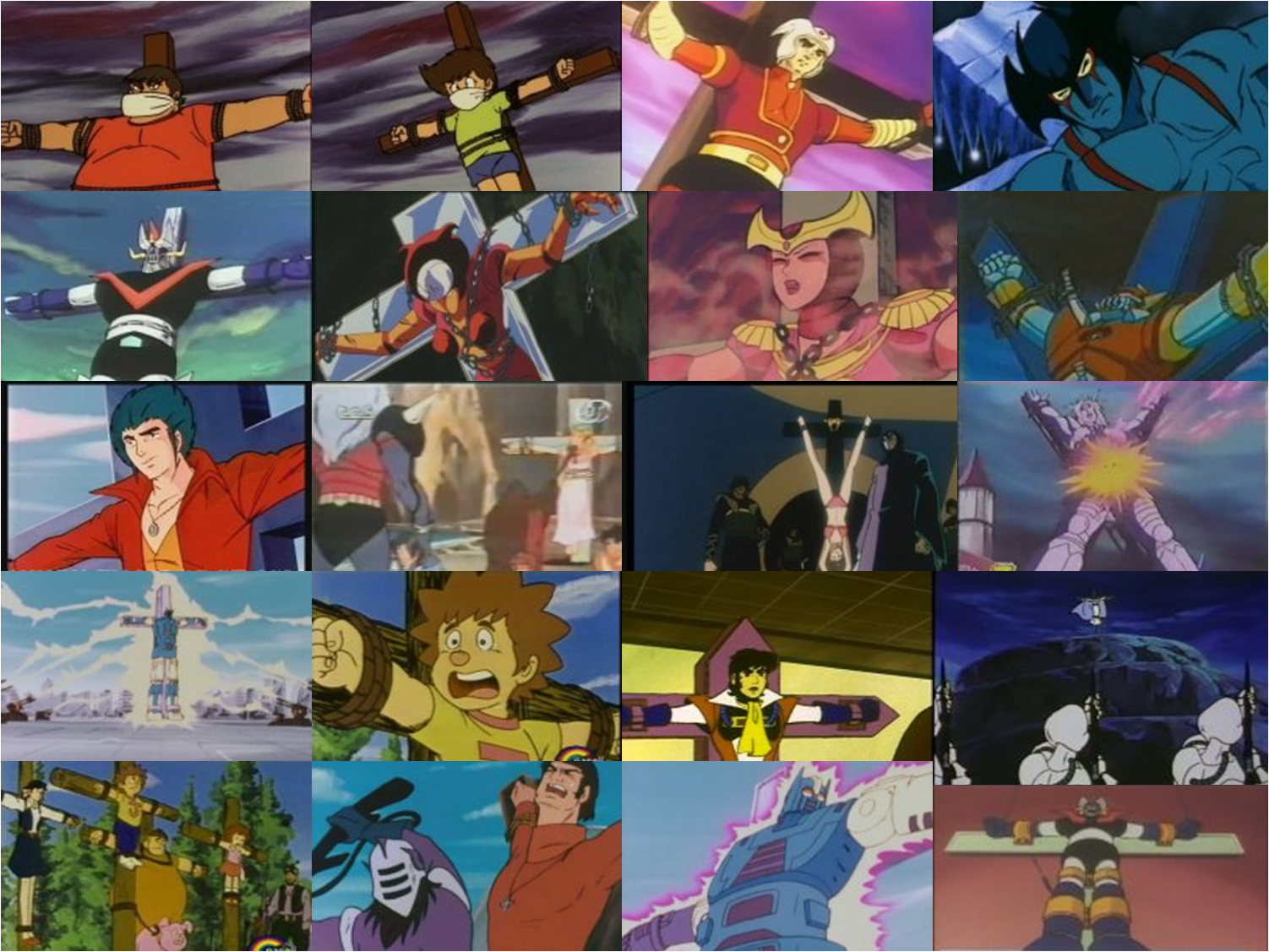
A compilation of crucifixions from super robot shows made by Ghostlighnting, from the blog We Remember Love
However, there is at least one bit of the general religious symbolism that’s meaningful, in that it’s been directly borrowed from Ideon: the idea of man creating a creature in its own image, that is the Eva. In Ideon, the robot is barely “created” – it’s an artifact from an ancient civilization, an object of legend and mythology. However, its humanoid shape is very often highlighted – the antagonists systematically refer to it as “the giant”, which in Japanese is literally written “big man”. For a machine to have a human shape is abnormal, it is even horrifying. The same happens in Evangelion, where the shapes of the Eva units are in stark contrast against the strange and otherworldly forms of the Angels.
But then why don’t we notice it ?
In sum, while Evangelion does offer an interesting and challenging take on its own generic tropes, it is by no means the first to do so. It could even be argued that, when Evangelion came out, these “tropes” had been challenged so much already that the fact of challenging them had in itself become a trope. Even kids’ shows, such as the Brave series, were more complex narratively and morally than their counterparts from the 70’s.
There’s still a question I wish to address, however, and I think it’s an important one: why do we keep believing, or want to believe, that Evangelion is supremely original and a total deconstruction of everything that had come before it ? The first and most obvious answer is ignorance: all Evangelion fans haven’t seen Ideon or Gundam, or any tokusatsu or kaiju movies, to cite only the biggest references the show makes. But I’d like to go deeper, because I think the show frames itself as this new thing that it was, but not in the way you’d expect.
Indeed, in its own title, Evangelion claims to be both a revolution of mecha, and the heir to a previous one. The Japanese title is Shinseiki Evangelion, so “Evangelion (Gospel) of the new century”. This “new century” could be understood in diverse ways, but it is firstly a reference to the “declaration of the new century of animation” (anime shinseiki sengen), an event held by Yoshiyuki Tomino on February 22, 1981, for the opening of the first Gundam movie. There, Tomino presented himself as the prophet of a new generation of anime fans, those that were starting to be called “otaku”. With its title, Evangelion puts itself in that lineage and Anno, Tomino’s friend, most probably intended to take up the role of messiah.
Moreover, Evangelion likes to cover its tracks, and tread in ambiguity. I mentioned that all the fanservice scenes could be read in two ways: pure, playful, expected panty shots, or occasions for unexpected ways to create character development. But that is true of the entire show, and that is precisely why it’s good: everything is both perfectly orthodox and going further. But that doesn’t have to mean that, because Evangelion is deeper and darker than what you’re expecting to see, it’s systematically devaluating all that is not like it. That’s most probably not the case, because the series does contain fanservice and otaku pandering; what it does is using them right, that is as exciting and meaningful moments.
But there’s also something in the show’s delivery that most non-hardcore fans are bound to miss. When we think “references” or “otaku pandering”, we think of something very obvious and on-your-nose. For example, when a reference is made in Lucky Star, it’s often very visible: the tone or art style suddenly changes, or the characters explicitly state what they’re referencing. That way, even if you don’t know what is being referenced (say, Gundam), you can still appreciate the fact that a reference is being made, and therefore appreciate the joke at a minimal level. But Evangelion doesn’t do that. Unlike Lucky Star, it expects its viewer to already master all of its references (which is obviously impossible) and will never explicitly tell you when its referencing something.

Lucky Star‘s not very subtle Gundam references
This explains two things. First, why most fans don’t realize that Evangelion makes those references: that’s because it never made them explicit to them. But also, and most importantly, why these fans don’t think that looking for references is relevant. Evangelion seems to exist in a vacuum, and if you haven’t already seen Ideon or Ultraman, there’s nothing that will point you towards it, or invite you to watch it. In that sense, Anno’s love letter to otaku culture might be a failure, in that it’s only for hardcore otaku, and will not, by itself, bring anyone to everything the show pays homage to.
Most of Evangelion’s good reputation in the non-Japanese fandom comes from its status as a “deconstruction”. More work would obviously have to be done, but I think I’ve sufficiently demonstrated that this label doesn’t fit the show at all. But then, if that’s what the show’s popularity rests on, is Evangelion still any good ? The very fact that I have to ask this question says a lot. It says a lot about the way we look at art and evaluate it. Indeed, we tend to think of originality as a constant quality: if something is original, it will at least be good because of that. In Evangelion‘s case, I’d say the reasoning is a bit different: because we like it and want to find objective reasons to justify that, we want it to be original, as original as possible. Which leads us to make mistakes and misunderstand at least some what it’s doing. Beyond the danger of misinterpretation, it’s doing a disservice to the work, because it rests on the idea that it’s not good enough on its own, that its qualities aren’t obvious enough and that we have to prove them by resorting to originality. But no show needs this less than Evangelion.
And that’s because, even if everything it does has been done before, it does it well. And make no mistake, it’s been done well before too. But being original doesn’t mean you can’t be singular. And Evangelion is singular, thanks to its flawless writing, direction, and even animation. I’m not going to show why here, as it’s not the purpose of this article. But I think the series speaks for itself in that regard. Evangelion isn’t original, not at all. But it’s still one of the greatest animated works of all time.
Like our content? Feel free to support us on Ko-Fi!
You might also be interested in
Benoît Chieux, a career in French animation [Carrefour du Cinéma d’Animation 2023]
Aside from the world-famous Annecy Festival, many smaller animation-related events take place in France over the years. One of the most interesting ones is the Carrefour du Cinéma d’Animation (Crossroads of Animation Film), held in Paris in late November. In 2023,...
Directing Mushishi and other spiraling stories – Hiroshi Nagahama and Uki Satake [Panels at Japan Expo Orléans 2023]
Last October, director Hiroshi Nagahama (Mushishi, The Reflection) and voice actress Uki Satake (QT in Space Dandy) were invited to Japan Expo Orléans, an event of a much smaller scale than the main event they organized in Paris. I was offered to host two of his...
Akira stories – Katsuhiro Otomo and Hiroyuki Kitakubo talk at Niigata International Animation Film Festival 2023
Among the many events taking place during the first Niigata International Animation Film Festival was a Katsuhiro Otomo retrospective, held to celebrate the 45th anniversary of Akira and to accompany the release of Otomo’s Complete Works. All of Otomo’s animated...

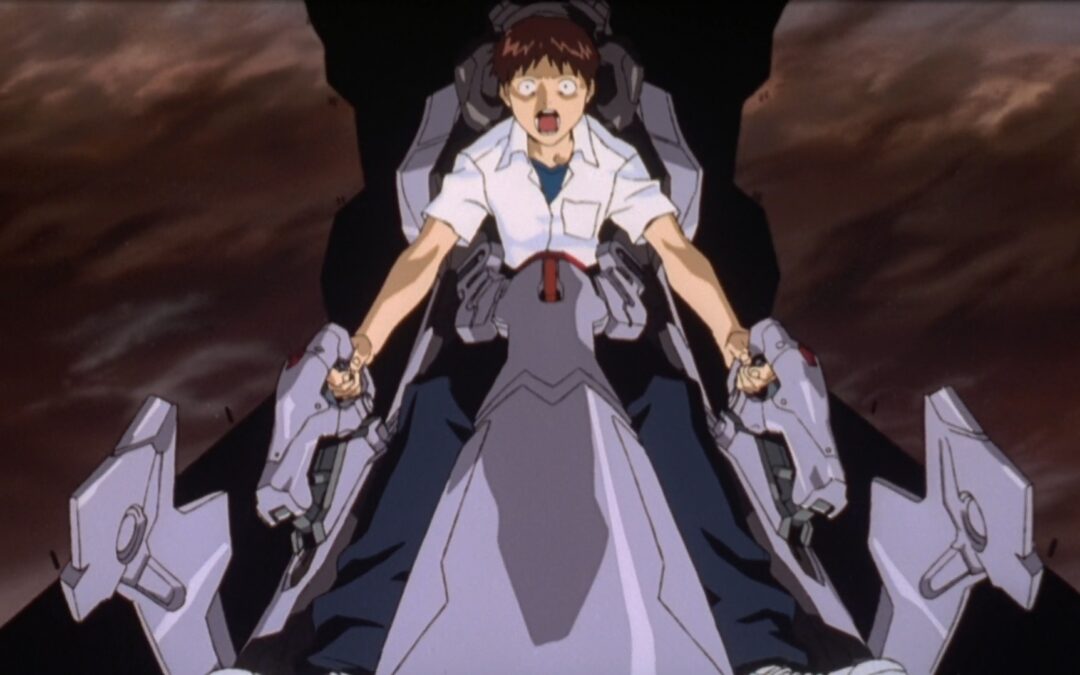
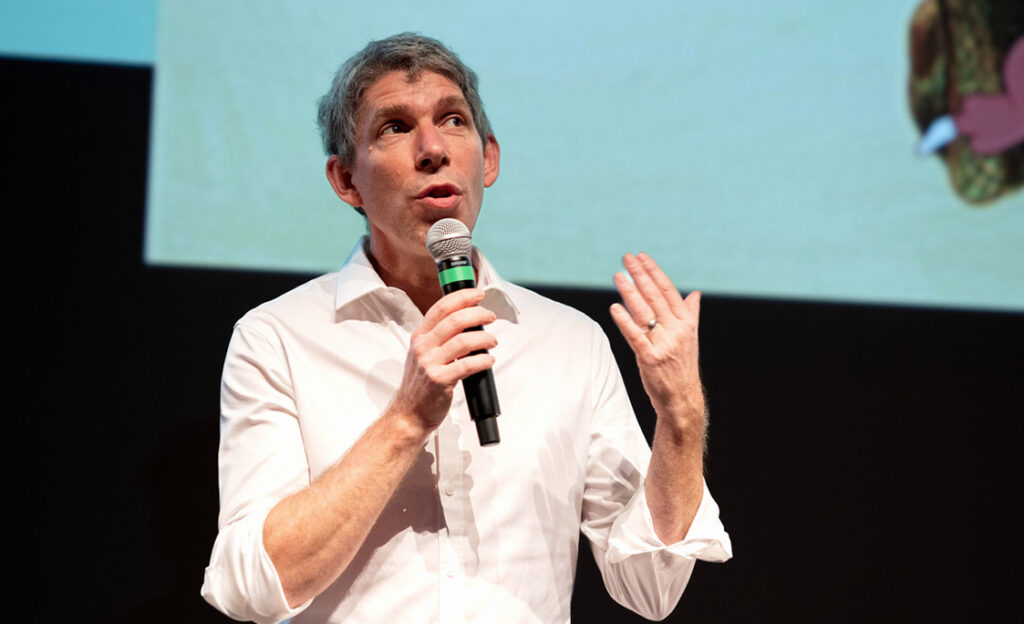
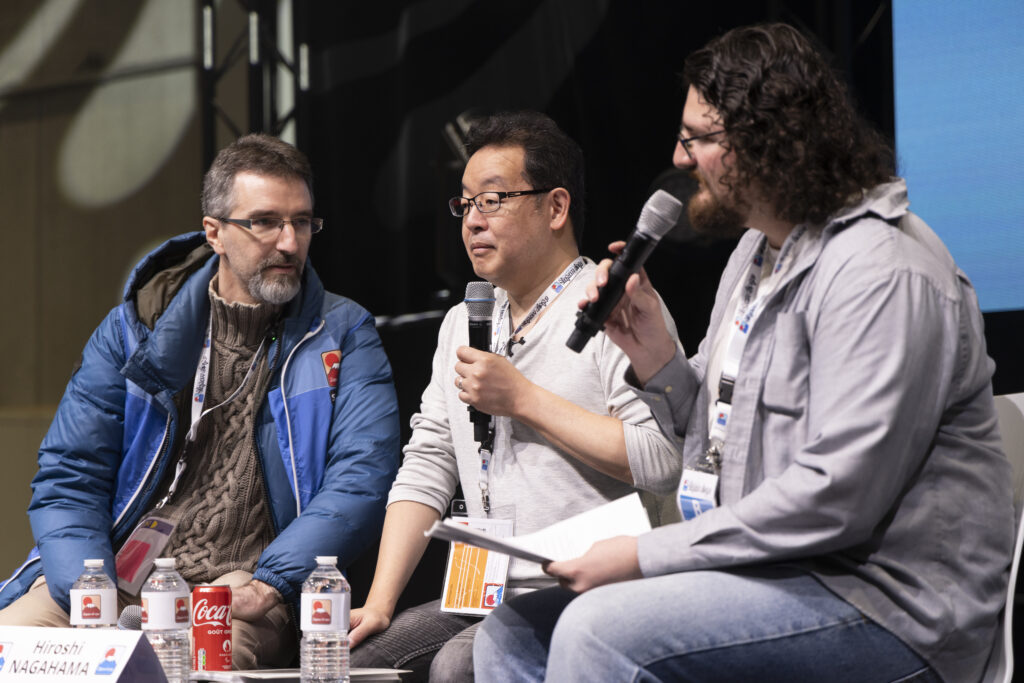
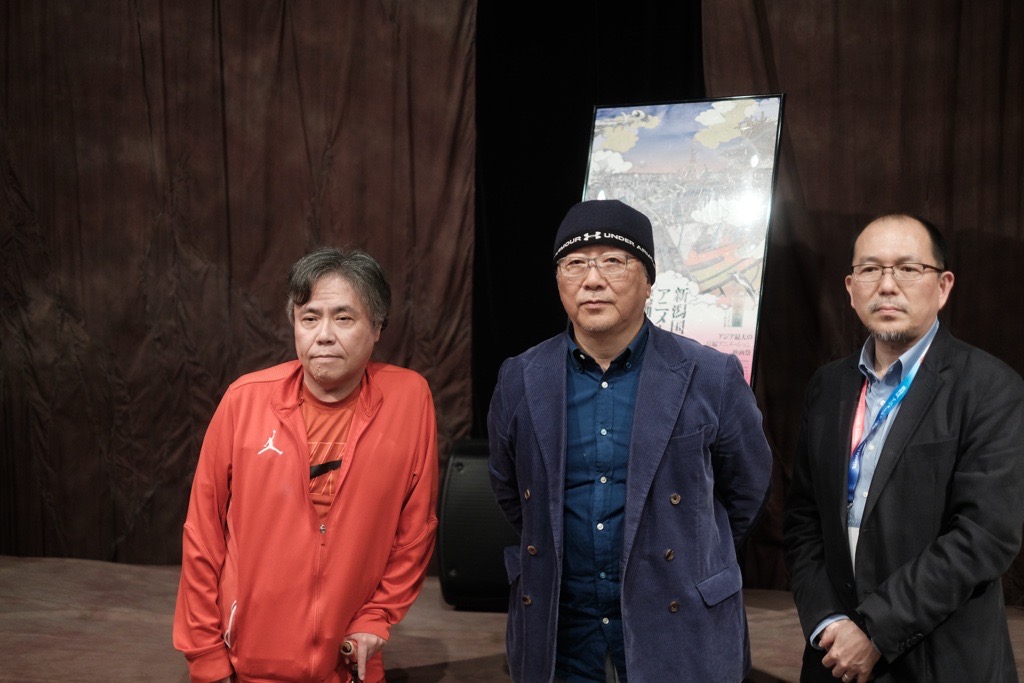
I’ve never expected to find an article/opinion based on facts when it comes to evangelion
there’s not only multiple references and series that inspired evangelion (mostly Gundam, Ideon, ultraman, godzilla, Mazinger Z..) but it’s what attracted the original viewer but even when this fact it’s well known in the mecha fandom there seems to be a cognitive dissonance if you look into the eva fandom itself (evageeks and other forums.)
I really enjoyed this essay! You make a lot of great points and I think you’re right that a lot of the discourse crediting Evangelion as a ‘deconstruction’ of the genre misses the mark. The over-interpretation of the show’s aesthetic trappings does a disservice, in my opinion, to the story what it captures about the world and cultural context that produced it.
Personally, I’m struck by how my experience of Evangelion has changed in light of the pandemic and have been surprised by how much I relate to the bleak and deeply cynical world the show depicts. I would argue that it’s in the world that exists outside of Shinji’s solipsistic narrative that the show is at its most interesting and effective, offering a depiction of the kinds of moral and ethical compromises society will make when faced with an unimaginable (and incomprehensible) crisis.
In light of the pandemic, I particularly resonated with the way that the Angels threaten the power and legitimacy of institutional authorities, and despite earnest efforts to muddle through as if everything were normal – and to a certain extent this show is a work-place drama – their increasingly complex efforts fail to protect society from destruction. Moreover, the show questions the ability of individuals to act in good faith in the interest of the collective or if individuals inevitably wield power in service of their own individualistic desires; e.i. Gendo’s secret plot to use the Angel’s to resurrect his wife, or, in our world, a president who allows a pandemic to spiral out of control in the service of election optics.
I might write an essay about this of my own.
Thanks for the great and very complete comment! That sounds like a great interpretation of the show, so if you ever write that essay I’d be curious to read it.
If you’d like to see more of this, however, I strongly encourage you to watch Anno’s Shin Gojira, if you haven’t already – it really explores further those ideas of disaster and institutional reaction to it. It seems to be something Anno’s interested in, exploring catastrophe – the bleak situation of 90’s Japan in Eva, the 2011 earthquake in Gojira.
It’s funny you say that because evangelion takes a lot of inspiration from a novel of Ryu Murakami about a virus. In the novel the virus is a menace that is both abstract and material, like the angels.
I enjoyed the article!
As someone who is is finishing up a PhD on a Hollywood screenwriter known for genre subversion, I find these discussions extremely perplexing, for a few reasons.
What do we mean when we say “deconstruction”? The term is not used in film studies, but it seems analogous to genre subversion or genre revisionism. This offers a few complexities though.
Subverting a genre does not suggest a complete undo of everything that came before. We consider The Wild Bunch a subversive work within the Western genre because it seems to emphasise a brutality that was only hinted at in Fordian works, and altogether it’s darker tone seems indicative of a more cynical political time. That does not mean that these themes began with Peckinpah. The Fordian western would often undermine the American national project, just not to the same degree.
Similarly a neo-noir like Night Moves dismantles a detective hero in order to progress postmodern themes of the subjectivity of reality and the limits of rational thought. But even its writer, Sharp, freely admitted in interviews these themes were present in every classic noir, he was just making them more overt.
Does Eva not follow this tradition? It didn’t originate it’s themes of identity atomisation or formal fragmentation (many of its editing quirks you can see in Dezaki for instance) but it certainly emphasised them more than previous mecha series.
>Does Eva not follow this tradition? It didn’t originate it’s themes of identity atomisation or formal fragmentation (many of its editing quirks you can see in Dezaki for instance) but it certainly emphasised them more than previous mecha series.
No, eva didn’t emphasised anything anymore than older mecha shows did previously. There’s a plethora of older mecha that did pretty much everything eva did before 1995. From Ideon, to tekkaman blade, to gundam shows and otaku mecha OVA’s like hades project Zeorymer & fight izher one. This goes on….